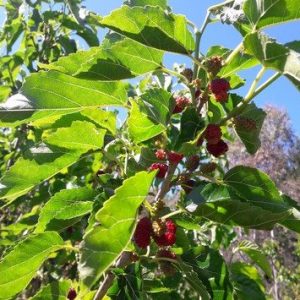LONG TERM OUT OF STOCK
SOLD OUT
OUT OF STOCK
AVAILABLE SPRING
AVAILABLE SUMMER
AVAILABLE AUTUMN
AVAILABLE WINTER
WINTER DORMANT
AVAILABLE SOON
Very long lived ornamental and fruit bearing deciduous tree native to SW Asia, also cultivated throughout Europe and around the Mediterranean for centuries. It was introduced to Britain by the Romans. Grows to a height of up to 10m (but can be kept lower with pruning), and has a deep rooting system. Fast growing when young, then very slow growing. Produces drupes of delicious 2-3cm purple/black fruit in early summer. Self-fertile, may also be pollinated by wind or bees.
PB5. Approx height 100-120 cm.
Photo needpix.com
Likes full sun, some shelter from strong winds, and well-drained loamy soil. Fairly drought-hardy once established but does seem to need good moisture levels to produce good fruit. Frost hardy when dormant but new buds are very susceptible to frosts. Otherwise low maintenance, and unfussy.
Mulberries have a long history of use in Chinese and Indian medicine to treat a variety of conditions in humans and animals, including colds, flu, eye infections toothache, diabetes, hypertension, and neurodegenerative diseases. The berries are rich source of antioxidant phenolic compounds, including flavonoids and anthocyanins.
Primary Actions: antioxidant, hypoglycemic, anti-inflammatory, antimicrobial, anti-melanogenic, antidiabetic, anti-obesity, anti-hyperlipidemic, and anticancer
Parts Used: fruit, leaves and bark



N.B. Shipping costs are added AFTER you have placed your order, you will then be emailed an invoice with bank details.

Smallest box rate:
This can fit up to 9 plants in 9cm pots.

Shipping a single tree can be expensive. We may be able to fit more in the box for the same price! See our shipping rates for single and multi tree boxes.

Combining sizes?
No problem, we will work out the best rate for you once you’ve placed your order.
Jo has a passion for growing herbs but is not a qualified herbalist and has no medical background.
We are lucky to have Patricia Beagle working here at times, who is qualified, and some of her advice does appear on these pages, but herbs act differently for different people and can interact with other medicines. We therefore always recommend that you consult with your own qualified health-care practitioner before using herbal products, particularly if you are pregnant, nursing or on any medications.
Kahikatea Farm cannot take any responsibility for any adverse effects from the use of the plants or a plant not having the effect it is reputed to have.

